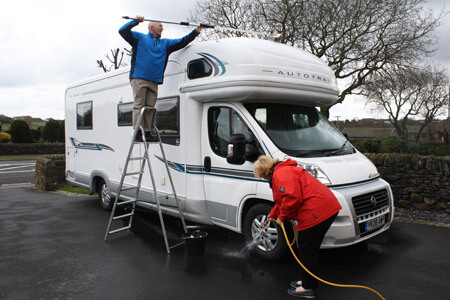Owning an RV opens up a world of adventure, offering the freedom to explore the great outdoors with all the comforts of home. However, maintaining your recreational vehicle is crucial to ensure these adventures remain enjoyable and hassle-free. One of the most common issues RV owners face is roof leaks. Whether caused by age, wear and tear, or improper maintenance, a leaking roof can quickly turn a dream trip into a nightmare. Fortunately, with the right tools and know-how, performing effective RV roof repair using lap sealant is a straightforward process that can save you time, money, and frustration.
Understanding Your RV Roof
Before diving into repairs, it’s essential to understand the construction of your RV’s roof. Most modern RVs feature one of three types of roofs: rubber (EPDM), fiberglass, or aluminum. Each material has its own set of characteristics and maintenance requirements. Rubber roofs, for example, are durable and relatively easy to repair, while fiberglass roofs offer a sleeker appearance but may require more frequent maintenance.
Regardless of the roof material, one common weak point is the seams and edges where different sections of the roof meet. These areas are prone to cracking, peeling, and separating over time, allowing water to seep into the RV and cause damage. That’s where lap sealant comes in.
Introducing Lap Sealant
Lap sealant, also known as RV roof sealant or dicor sealant, is a flexible, waterproof sealant specifically designed for use on RV roofs. It comes in tubes or cartridges and is typically applied with a caulking gun. Lap sealant is formulated to adhere to a variety of roof materials, including rubber, fiberglass, and aluminum, making it a versatile solution for most RV owners.
One of the key advantages of lap sealant is its flexibility. Unlike traditional caulks or sealants, which can become brittle and crack over time, lap sealant remains pliable, allowing it to move with the natural expansion and contraction of the RV roof without losing its seal. This flexibility is essential for long-lasting repairs that can withstand the rigors of travel and weather exposure.
Preparing for Repairs
Before starting any repairs, gather the necessary tools and materials:
- Lap Sealant: Choose a high-quality lap sealant designed specifically for RV roofs. Look for products that offer UV resistance and long-lasting flexibility.
- Caulking Gun: A standard caulking gun will be needed to apply the sealant evenly.
- Utility Knife: Use a sharp utility knife to remove old sealant and clean the repair area.
- Cleaner/Primer: Depending on the condition of your roof, you may need a cleaner or primer to prepare the surface for sealing.
- Protective Gear: Wear gloves and safety glasses to protect your hands and eyes during the repair process.
Once you have everything you need, it’s time to inspect the roof for damage. Look for signs of cracking, peeling, or separation along the seams, edges, and around any roof-mounted fixtures such as vents, antennas, or air conditioners. Mark any areas in need of repair with a pencil or masking tape for easy reference.
Step-by-Step Repair Process
-
Clean the Repair Area: Use a cleaner or solvent recommended for your roof material to remove dirt, grime, and old sealant from the repair area. Allow the surface to dry completely before proceeding.
-
Remove Old Sealant: Carefully use a utility knife to cut away any old or damaged sealant from the seams and edges of the roof. Take your time and work slowly to avoid damaging the roof material underneath.
-
Apply Primer (if necessary): If your roof manufacturer recommends using a primer before applying sealant, follow their instructions carefully. Apply the primer to the cleaned and dried repair area and allow it to dry completely before proceeding.
-
Load Sealant into Caulking Gun: Insert the tube or cartridge of lap sealant into the caulking gun and cut off the tip at a 45-degree angle to create a small opening. Be sure to use a compatible caulking gun size for your sealant cartridge.
-
Apply Sealant: Starting at one end of the repair area, carefully apply a bead of lap sealant along the seam or edge using steady pressure on the caulking gun trigger. Work in small sections, smoothing the sealant with a putty knife or your gloved finger as you go to ensure even coverage and a tight seal.
-
Inspect and Touch Up: Once you’ve applied sealant to the entire repair area, carefully inspect your work for any gaps or missed spots. Use additional sealant to fill in any gaps and ensure a watertight seal.
-
Allow Sealant to Cure: Depending on the product you’re using, allow the sealant to cure for the recommended amount of time before exposing it to water or other elements. This curing time is essential for the sealant to fully bond to the roof surface and achieve maximum effectiveness.
-
Clean Up: Once the sealant has cured, clean up any excess or spilled sealant using a solvent recommended by the manufacturer. Dispose of used materials properly according to local regulations.
Maintenance Tips for Long-Term Protection
Performing regular inspections and maintenance can help prevent roof leaks and extend the life of your RV’s roof. Here are some tips to keep in mind:
-
Inspect Your Roof Regularly: Make it a habit to inspect your RV’s roof at least twice a year, preferably before and after the camping season. Look for signs of damage, wear, or deterioration, and address any issues promptly.
-
Clean Your Roof: Keep your RV’s roof clean by removing debris, leaves, and other obstructions that can trap moisture and promote mold or mildew growth. Use a mild detergent and water solution to clean the roof surface, avoiding harsh chemicals that could damage the roof material.
-
Check Seals and Caulking: Inspect the seals around roof-mounted fixtures such as vents, antennas, and air conditioners for signs of cracking or separation. Reapply lap sealant as needed to maintain a watertight seal and prevent leaks.
-
Protect Against UV Damage: UV rays from the sun can cause roof materials and sealants to degrade over time. Consider applying a UV protectant or roof coating to help shield your RV’s roof from sun damage and extend its lifespan.
-
Store Your RV Properly: When not in use, store your RV in a covered area or use an RV cover to protect it from the elements. This will help prevent premature aging and deterioration of the roof and other exterior components.
By following these maintenance tips and performing regular inspections and repairs as needed, you can keep your RV roof in top condition and enjoy leak-free adventures for years to come.
Conclusion
A leaking roof is a common issue faced by RV owners, but it doesn’t have to ruin your outdoor adventures. With the right tools, materials, and know-how, performing effective roof repairs using lap sealant is a straightforward process that can save you time, money, and frustration. By understanding your RV’s roof construction, preparing properly for repairs, and following a step-by-step process, you can ensure a watertight seal that withstands the rigors of travel and weather exposure. With regular maintenance and inspections, you can keep your RV roof in top condition and enjoy leak-free adventures for years to come.










